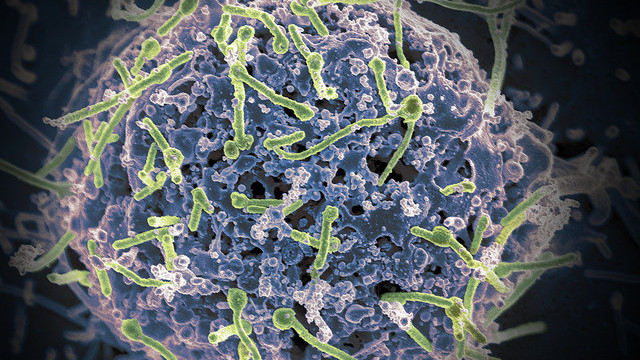Ebola virus causes hemorrhagic fever with a high incidence and mortality rate and for which there is no approved therapy. According to statistics from the World Health Organization, since it has been found in 1976, Ebola virus has been raging in Africa for nearly 40 years; in March 2014, an outbreak in Guinea, Liberia and Sierra Leone of Ebola quickly spread across West Africa, resulting in a total of over 28,000 people infected, and more than 11,000 deaths.
The medical staff and scientists around the world have involved in this viral campaign. However, the Ebola virus is difficult to culture in the laboratory, making the drug testing quite difficult, thus the treatment of this viral infection has not changed much.
Recently, the good news is scientists at the National Institute of Allergy and Infectious Diseases (NIAID) and colleagues have discovered that a single monoclonal antibody–a protein that attacks viruses–isolated from a human Ebola virus disease survivor, protected non-human primates when given as late as five days after infection with the Ebola virus.
The antibody can now advance to testing in humans as a potential treatment for Ebola virus disease. These new findings are described in two articles to be published online by Science on February 25.
NIAID researchers obtained and tested blood samples from a survivor of the 1995 Ebola outbreak in Kikwit, Democratic Republic of the Congo, and discovered the survivor retained antibodies against Ebola. Investigators from the Institute for Research in Biomedicine in Switzerland then isolated specific antibodies for potential use as a therapeutic for Ebola infection.
Then, investigators from the United States Army Medical Research Institute of Infectious Diseases administered a lethal dose of Zaire ebolavirus to four rhesus macaques, waited five days, and then treated three of the macaques with daily intravenous injections of the monoclonal antibody, known as mAb114, for three consecutive days. The untreated control macaque showed indicators of Ebola virus disease and died on day nine, but the treatment group survived and remained free of Ebola symptoms.
NIAID and Dartmouth College researchers then studied how mAb114 neutralizes the Ebola virus and determined that it binds to the core of the Ebola glycoprotein, blocking its interaction with a receptor on human cells. This area of the Ebola glycoprotein, called the receptor binding domain, was previously thought to be unreachable by antibodies because it is well-hidden by other parts of the virus, and only becomes exposed after the virus enters the inside of cells.
This is the first antibody to demonstrate the ability to neutralize the virus by this interaction between the virus and its cellular receptor. Together the evidence identifies a novel site of vulnerability on the Ebola virus and suggests mAb114 could be an effective therapy and warrants further exploration, according to the authors.
Story Source: ScienceDaily
Journal References:
D Corti et al. Protective Monotherapy Against Lethal Ebola Virus Infection by a Potent Neutralizing Antibody. Science, 2016
J Misasi et al. Structural and Molecular Basis for Ebola Virus Neutralization by Protective Human Antibodies. Science, 2016

